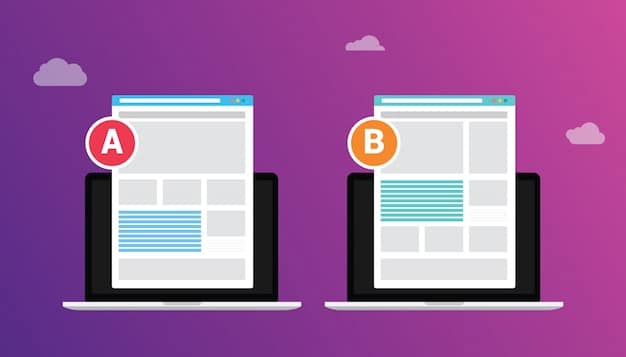ADA Website Accessibility Guidelines 2025: Impact on Customer Experience

The updated 2025 ADA website accessibility guidelines will significantly impact your customer experience strategy by mandating inclusive design practices that cater to users with disabilities. These changes will require businesses to prioritize accessible website features to ensure compliance and enhance overall user satisfaction.
How well does your current website serve individuals with disabilities? As we approach 2025, updated ADA website accessibility guidelines are set to reshape digital customer experiences. Understanding how will the updated 2025 ADA website accessibility guidelines impact your customer experience strategy is not just about compliance, it’s about inclusivity and reaching a broader audience.
Let’s delve into the core changes and how they can be strategically integrated to enhance user satisfaction and loyalty. What proactive steps can your business take to adapt and thrive in this evolving landscape?
Understanding the 2025 ADA Website Accessibility Updates
The Americans with Disabilities Act (ADA) has long been a cornerstone for ensuring accessibility in the physical world. Now, its relevance extends even further into the digital realm. It’s paramount to understand how will the updated 2025 ADA website accessibility guidelines impact your customer experience strategy.
Key Changes in the Updated Guidelines
Several important updates highlight the evolving requirements. These changes are designed to provide more specific and actionable guidance to website developers and content creators.
- Enhanced focus on mobile accessibility: Accommodating the increasing use of mobile devices by users with disabilities.
- Clearer standards for video and audio content: Providing captions, transcripts, and audio descriptions as necessary.
- Improved navigation and structure: Ensuring websites are easy to navigate using assistive technologies.
These updates aim to create a more inclusive online environment, ensuring that all users, regardless of their abilities, can access and interact with digital content effectively.

The anticipated accessibility guidelines underscore the necessity of aligning with standards like WCAG 2.2 to meet legal requirements and broaden your audience reach. It’s crucial to stay informed about how these changes will affect your overall customer experience approach.
The Direct Impact on Your Customer Experience
The essence of customer experience (CX) lies in every interaction a customer has with your brand. So, how will the updated 2025 ADA website accessibility guidelines impact your customer experience strategy? It goes beyond mere compliance, influencing brand perception, loyalty, and even revenue.
Enhancing User Satisfaction and Loyalty
When websites are accessible, users with disabilities can navigate, understand, and interact with content just like anyone else. This leads to increased satisfaction, fostering stronger relationships and long-term loyalty.
By adhering to the updated guidelines, you not only comply with legal requirements but also demonstrate a commitment to inclusivity and customer-centric values.
Expanding Your Reach to a Broader Audience
Accessibility is not just about helping users with disabilities; it often improves the experience for all users. An accessible website tends to be more user-friendly, which can attract and retain a broader audience.
- Improved SEO: Accessible websites tend to rank higher in search engine results, attracting more organic traffic.
- Enhanced usability: Accessible design principles often lead to better overall website usability.
- Positive brand image: Demonstrating a commitment to inclusivity can enhance your brand’s reputation.
Essentially, integrating accessibility into your customer experience strategy can provide a competitive edge while promoting social responsibility.
Integrating Accessibility into Your CX Strategy
Now that we’ve explored the importance of ADA compliance, let’s consider how will the updated 2025 ADA website accessibility guidelines impact your customer experience strategy? It involves several crucial steps and considerations.
Conducting an Accessibility Audit
The first step is to assess your website’s current level of accessibility. An audit will help identify areas that need improvement and provide a roadmap for addressing them. Several automated tools and manual testing methods can be used for this purpose.
When planning an accessibility audit, it is essential to involve users with disabilities in the testing process. Their feedback can provide valuable insights into the practical challenges they face when interacting with your website.
Implementing Accessible Design Principles
Once you have a clear understanding of your website’s accessibility gaps, you can start implementing accessible design principles. This involves making changes to various elements of your website, including:
- Semantic HTML: Use appropriate HTML tags to structure content logically.
- Alternative text for images: Provide descriptive alternative text for all images.
- Keyboard navigation: Ensure that all website features can be accessed using the keyboard.
- Sufficient color contrast: Maintain adequate contrast between text and background colors.
By incorporating these design principles, you’re not just aligning with ADA standards; you’re also creating a more user-friendly environment for everyone.

Considering the evolving needs of your audience and incorporating these principles, you can transform your website into an inclusive platform that positively impacts customer experiences.
Tools and Resources for ADA Compliance
Navigating the intricacies of ADA compliance can seem daunting, but numerous tools and resources are available to help. Understanding these resources is essential for managing how will the updated 2025 ADA website accessibility guidelines impact your customer experience strategy.
Automated Testing Tools
Automated testing tools are invaluable for quickly identifying accessibility issues on your website. These tools can scan your pages and generate reports highlighting violations of accessibility standards, such as WCAG.
Examples of commonly used automated testing tools include:
- WAVE (Web Accessibility Evaluation Tool): A free tool provided by WebAIM (Web Accessibility In Mind).
- Axe DevTools: A browser extension by Deque Systems that integrates directly into your development workflow.
- Google Lighthouse: An open-source, automated tool integrated into Chrome DevTools.
While automated tools are helpful, they should be used in conjunction with manual testing to ensure comprehensive coverage.
Educational Resources and Training Programs
Several organizations offer educational resources and training programs to help you and your team deepen your understanding of accessibility best practices. These resources can range from online courses to in-person workshops.
Key providers of accessibility training include:
- WebAIM: Offers extensive resources, articles, and training materials on web accessibility.
- Deque University: Provides online courses and certifications in digital accessibility.
- The Paciello Group: Offers comprehensive accessibility consulting and training services.
Investing in training can empower your team to create and maintain accessible websites effectively.
Long-Term Benefits of Accessible CX
The discussion around how will the updated 2025 ADA website accessibility guidelines impact your customer experience strategy should emphasize the significant long-term benefits that go beyond legal compliance. Investing in accessibility delivers value to your business and customers in various ways.
Building a Reputation for Social Responsibility
Customers are increasingly drawn to brands that demonstrate a commitment to social responsibility. By making your website accessible, you send a powerful message that you value inclusivity and care about all your customers.
This commitment enhances your brand image and can foster greater customer loyalty.
Driving Innovation and Competitive Advantage
Adopting accessible design practices can drive innovation by encouraging your team to think creatively and develop more user-friendly solutions. Accessible design often leads to better overall usability, which can give you a competitive advantage.
“`html
| Key Point 🔑 | Brief Description 📝 |
|---|---|
| 🎯 Updated ADA Guidelines | Focus on enhanced digital accessibility standards for websites. |
| 🌐 Customer Experience Impact | Accessibility directly influences user satisfaction and broader audience reach. |
| 🛠️ Implementation Steps | Conduct audits, implement accessible design to improve CX. |
| 📈 Long-Term Benefits | Enhance reputation, drive innovation with accessible design practices. |
“`
Frequently Asked Questions (FAQ)
The updated guidelines focus on mobile accessibility, clearer standards for video and audio content, and improved navigation.
Accessible websites often rank higher in search engine results because they are more user-friendly. Improved structure and alt text contribute to better indexing.
Small businesses need to ensure their websites are compliant to avoid legal issues and broaden their customer base by catering to users with disabilities.
Tools like WAVE, Axe DevTools, and Google Lighthouse can help identify accessibility issues and provide insights into areas that need improvement.
Prioritizing accessibility improves overall user satisfaction, fosters customer loyalty, and enhances your brand’s reputation by demonstrating inclusivity and commitment.
Conclusion
Understanding how will the updated 2025 ADA website accessibility guidelines impact your customer experience strategy is crucial for future-proofing your digital presence. Prioritizing website accessibility not only ensures compliance but also enriches user experience.
By taking proactive steps to align with these guidelines, companies can enhance their brand image, improve user satisfaction, and achieve a competitive advantage in an increasingly inclusive digital world.





